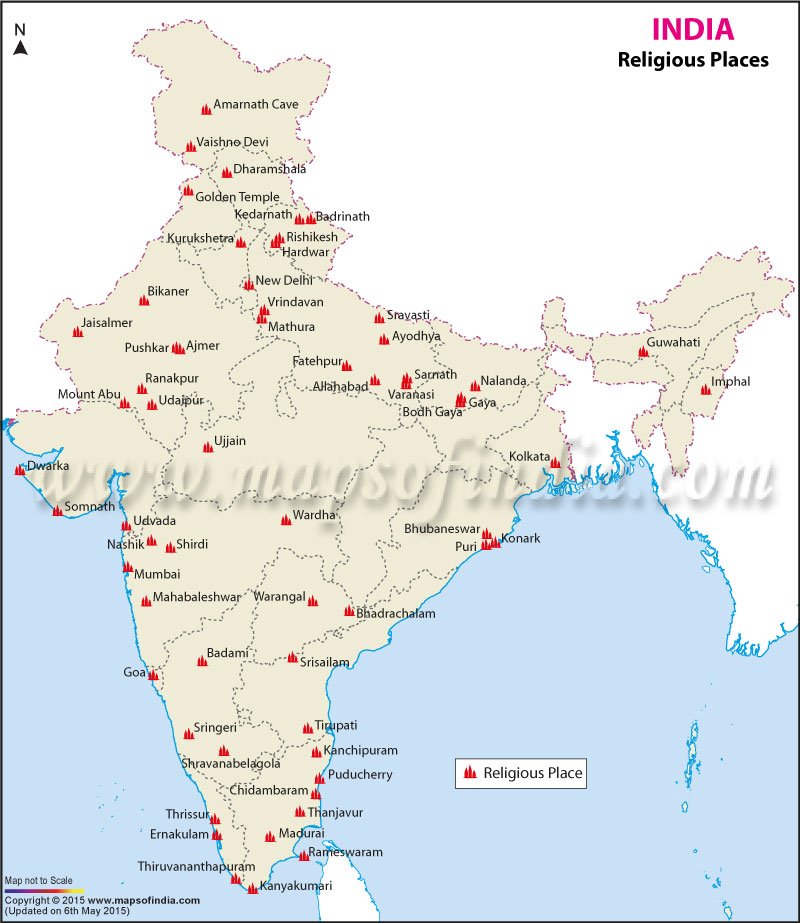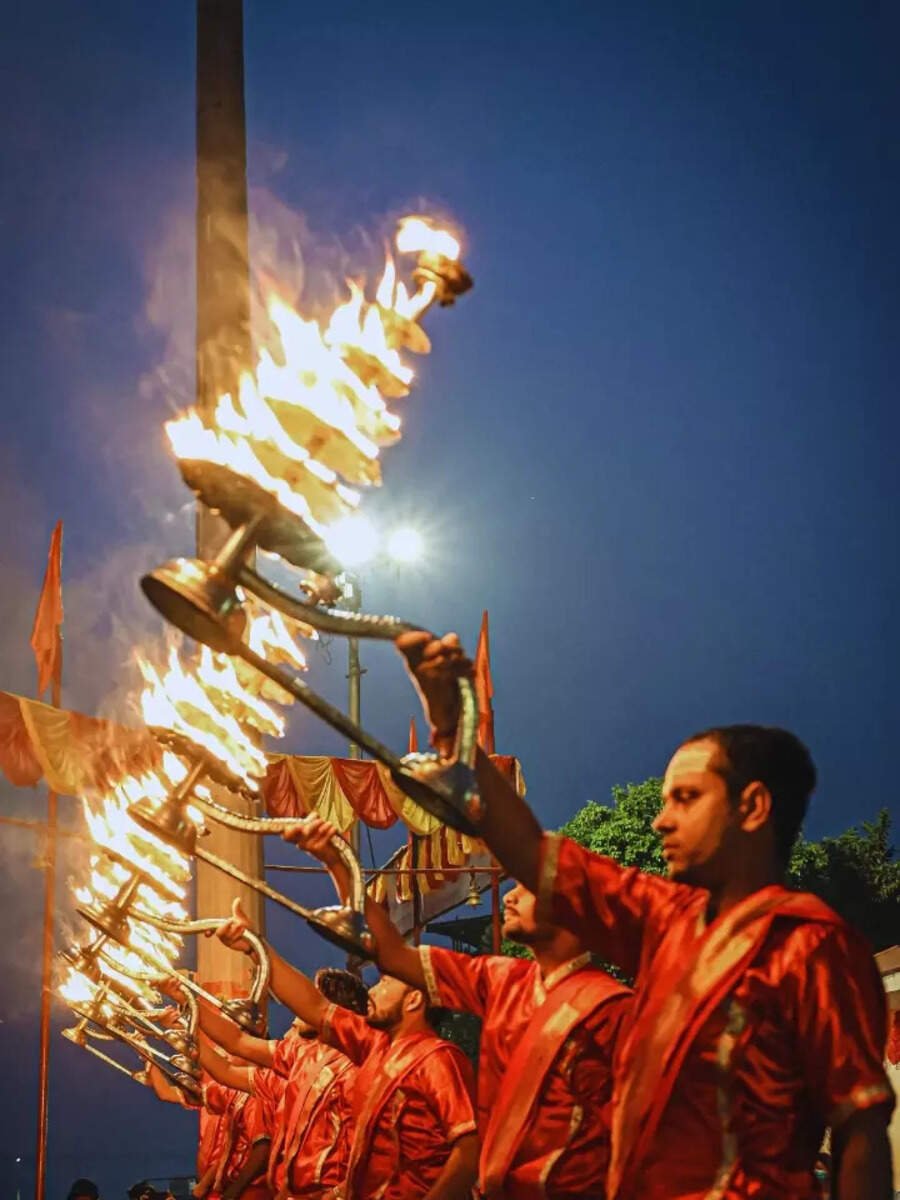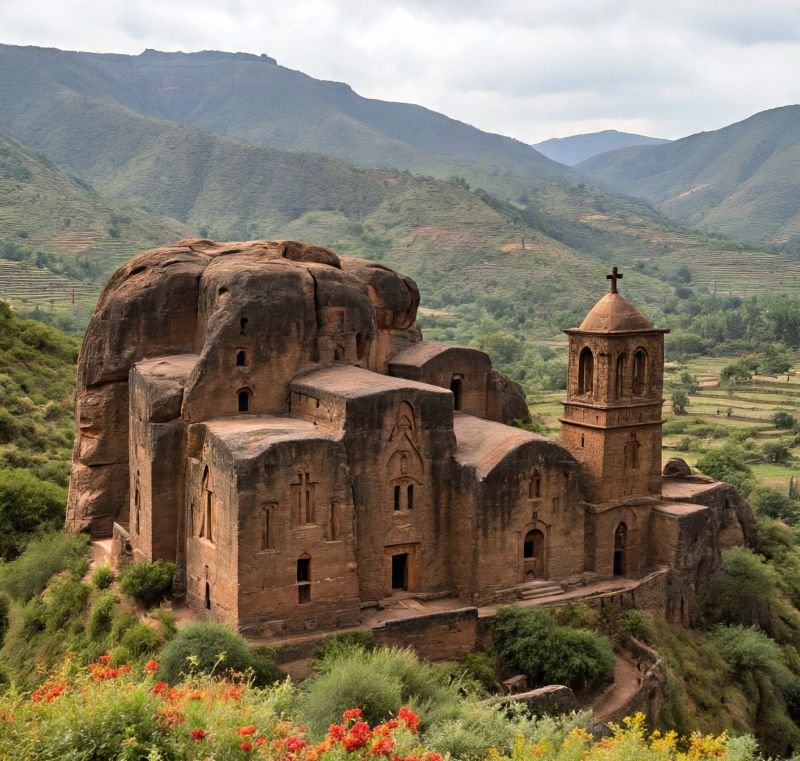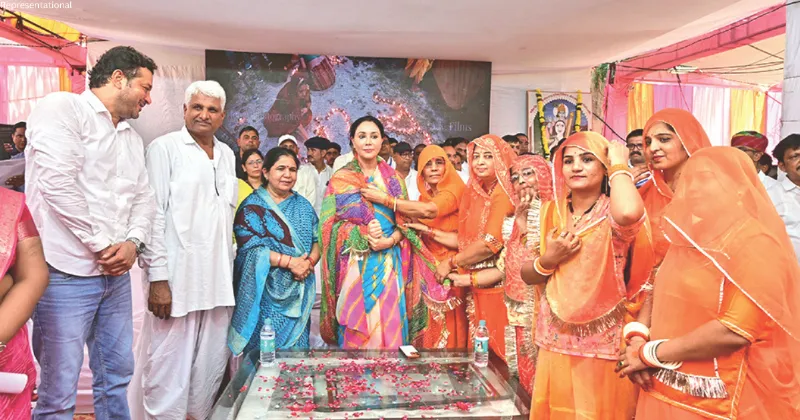Spiritual Travel
Religious Places in India

There are a large number of temples, mosques, gurudwaras, churches and monasteries which are visited by people from different religions. These religious sites are the places where the physical world meets the spiritual world and where the hearts are filled with divine holiness and spirituality. India is a ‘Land of Faith’, where the spiritual air has a fragrance of Karma, Dharma and Forgiveness. The secular India believes in the philosophy of sarva dharma sambhava, which means equality and respect for all religions. The religious places in India are not confined to any particular region or state but are spread across the country.
Following are some religious places categorised on the basis of religions and beliefs in India:
Hinduism
Char Dhams: For a Hindu, Char Dham Yatra is a complete pilgrimage. The four pilgrimage sites are located in four different directions.
- Badrinath Temple – Located in Uttarakhand, it is a temple dedicated to Lord Vishnu.
- Jagannath Temple – Dedicated to Lord Jagannath in Puri, Odisha; it is popular for its annual Rath Yatra.
- Rameswaram Temple – Located in Rameswaram in the South, it is dedicated to Lord Shiva.
- Dwarakadhish Temple – This temple, dedicated to Lord Krishna, is situated in Dwarka, Gujarat.
In the Himalayas, there is a pilgrimage circuit in Uttarakhand, known as Chota Char Dham- Badrinath, Kedarnath, Gangotri and Yamunotri.
Amarnath: Located in Jammu and Kashmir, the holy shrine Amarnath is devoted to Lord Shiva. Every year, a yatra to the Amarnath cave is held for the pilgrims to worship the ice stalagmite Lingam.
Vaishno Devi: Situated on the Trikuta Mountains in Jammu and Kashmir, this shrine is dedicated to Maa Vaishno. There are three natural rock formations known as Pindies which are worshipped here.
Kamakhya Temple: Located in Guwahati, Assam, it is one of the oldest Shakti Peethas dedicated to Goddess Kamakhya. Thousands of tantra devotees attend the annual festival, Ambubachi Mela, held in this temple.
Tirumala Venkateswara Temple: Located in Tirupati, this temple is devoted to Lord Venkateswara, who is also known by different names such as Balaji, Srinivasa and Govinda.
Siddhivinayak Temple: Devoted to Lord Ganesha, this is one of the most popular temples in Mumbai. It has also gained popularity due to visits by politicians and bollywood celebrities besides common people.
Shirdi Sai Temple: Located in Shirdi, Maharashtra, it is a holy shrine of Shirdi Sai Baba. The temple, visited by a large number of devotees every year, is spread in an area of approximately 200 sq. meters.
Somnath Jyotirlinga: Dedicated to Lord Shiva, this place, located in Gujarat, is a source of spirituality and divinity among many Hindu pilgrims. It is the first among the twelve jyotirlinga shrines of Shiva in the country.
Meenakshi Amman Temple: The Meenakshi Amman Temple in Madurai is dedicated to Goddess Parvati who is also known as Meenakshi.
Brahma Temple: The Brahma Temple in Pushkar is the only temple in the world dedicated to the deity. The temple is believed to be about 2000 years old.
Sabarimala Sree Dharma Sastha Temple: Dedicated to Lord Ayyappa, it is the most popular of the Sastha temples in Kerala. It is one of the only temples in India which is open for people of all religions and faiths.
Kumari Amman Temple: It is the most famous temple in Kanyakumari, devoted to Goddess Kumari Amman, also known as Kumari Bhagavathy Amman. It is one of the Shakti Peethas in India, and is the first Durga Temple made by Lord Parasurama.
Shakti Peethas: There are more than 50 Shakti Peethas in India. They are dedicated to goddess sati or Shakti. Some of the Shakti Peethas are Chhinnamastika Shakti Peeth at Chintpurni in Himachal Pradesh; Mahalakshmi Temple in Kolhapur, Maharashtra; Kamakshi Amman Temple in Kanchipuram, Tamil Nadu; Chamundeshwari Temple in Mysore, Karnataka; Vishalakshi Temple in Varanasi, Uttar Pradesh; Jwala Ji Temple in Himachal Pradesh; Nandikeshwari Shakti Peeth in Nandipur, West Bengal; Vimala (Bimala) Temple in Puri, Odisha; Kalmadhava Shakti Peeth in Amarkantak, Madhya Pradesh and many more.
Mathura-Vrindavan: Lord Krishna was born in Mathura and spent his childhood in Vrindavan. These places have many temples dedicated to Lord Krishna and his beloved Radha.
Haridwar: It is located in Uttarakhand and is considered as an ideal place to start a pilgrim journey to Mount Kailash.
Varanasi: Also known as Kashi, this ancient city is also referred as the holy city of India. The ghats and the temples of the city attract large number of Hindu devotees.
Besides the above mentioned prominent places, there are innumerable temples in India and religious destinations like Allahabad, Ujjain, Nashik, Rishikesh, Gaya, Madurai, Mahabaleshwar and many more hold their significance and importance especially among the Hindus.
Islam
Hazratbal: The shrine of Hazratbal is located in Srinagar and is popular because it contains the relics of Prophet Mohammad. The devotees are allowed to view the relic only once a year and therefore, it attracts a large number of pilgrims during this occasion.
Jama Masjid: Built by Mughal Emperor Shah Jahan, this mosque is located in Old Delhi. It contains some relics of the Muhammad and can accommodate thousands of devotees to worship together.
Cheraman Juma Masjid: Situated in Kerala, it is considered to be the first mosque in India. Malik Ibn Dinar, the first follower of Prophet Muhammad built it in 629 A.D.
Taj-ul-Masajid: This mosque in Bhopal, Madhya Pradesh is one of the biggest mosques in Asia. The literal meaning of the name of this mosque is crown-among-mosques.
Mecca Masjid: This Hyderabad-based masjid is one of the largest masjids in India. It is constructed from the bricks which were made by the soil brought from Mecca, the holiest Islamic site.
There are numerous mosques and dargahs in India. Some of the important mosques in India are Aasfi Masjid, Lucknow; Charminar, Hyderabad; Moti Masjid, Delhi; Sir Syed masjid, Aligarh; Tipu Sultan Shahi, Kolkata and many more.
Sikhism:
Golden Temple: The Golden Temple of Amritsar, also known as Harminder Sahib, is considered as the most prominent shrine of the Sikhs. The four doors of the temple symbolise that it is open for people of all religions and beliefs.
Anandpur Sahib: It is known as ‘the holy city of bliss’ and is a part of Rupnagar district in Punjab. Takht Sri Keshagarh Sahib is the main gurudwara and major attraction in Anandpur Sahib.
Damdama Sahib: Located in Bhatinda, Punjab, it is the ‘Seat of Temporal Authority’ and is one of the most revered takhts of the Sikhs.
Patna Sahib: Takht Patna Sahib, also known as Takht Sri Harmandir Ji, is the birthplace of the tenth guru Sri Guru Gobind Singh and is situated in Patna, Bihar.
Hazur Sahib: Takht Sachkhand Shri Hazur Abchalnagar Sahib is located in Nanded, Maharashtra, and is one of the five takhts of the Sikhs. It is also one of the highest temporal seats of authority and is the place where Guru Gobind Singh Ji took his last breath.
Hemkund Sahib: Located in Chamoli district of Uttarakhand, it is dedicated to the tenth Sikh Guru, Guru Gobind Singh Ji.
Gurudwara Paonta Sahib: The Paonta Sahib Gurudwara is dedicated to Guru Gobind Singh Ji and is situated in Sirmour district of Himachal Pradesh. It has a religious significance as it houses the book Dasam Granth, written by Guru Gobind Singh Ji.
Bangla Sahib Gurudwara: Located in central Delhi, this place earlier belonged to Raja Jai Singh but was later transformed into a gurudwara in the memory of Guru Har Kishan Ji.
Rakab Ganj Gurudwara: This Delhi-based gurudwara stands as homage to Guru Tegh Bahadur as his headless body was incinerated here after he was slaughtered by the Mughals.
Sis Ganj Gurudwara: It is one of the oldest and the historical gurudwaras in Delhi. It is dedicated to Guru Tegh Bahadur and his disciples who were beheaded in Chandni Chowk by the Mughals.
Christianity:
Bascilica of Bom Jesus: Located in Goa, it is the first Indian church to be brought to the status of Minor basilica and is known for the tomb of St. Francis Xavier.
St. Cajetan Church: This Goa-based Church has a structure similar to that of St. Peter’s Church in Rome. The church is an example of Renaissance and Christian architecture.
St. Francis of Assisi: Located in Goa, it is a former palace of the Archbishop and connects the Se Cathedral to the Church of St. Francis of Assisi and the Convent. It was a convent before but later converted into a church in 1521 for the Franciscan friars.
Santa Cruz Basilica: This church in Kerala was originally built by the Portuguese and elevated to a cathedral in 1558 AD by Pope Paul IV. After experiencing demolition and reconstruction, it was finally proclaimed a Basilica by Pope John Paul II in 1984.
Little Mount Church: The Shrine of Our Lady of Good Health is a popular church in Chennai and is one of the oldest churches in the country.
Cathedral Church of St. Thomas: This is the first Anglican Church of the Mumbai city. Its foundation was laid in 1672 and was completed in 1718 after which it was open for general public.
Christ Church & St. Michael’s Cathedral: Situated on the popular Mall Road of Shimla, Himachal Pradesh, this church is considered to be the second oldest church of North India.
Cathedral of the Sacred Heart: This Roman Catholic cathedral is one of the oldest churches in Delhi. Here, the Christian religious services are held throughout the year.
Kanpur Memorial Church: It was originally known as All Souls’ Cathedral and was built in 1875 in the honour of the British who lost their lives during the war of 1857.
Other popular churches in India are Church of St. Andrew, Church of St. Francis Xavier, Cathedral Church, Church & Cathedral of St. Monica, The Chapel of Our Lady of the Mount and Mater Dei Church. All these churches are located in Goa. Some other renowned churches outside Goa are Catholic Church, Sardhana; St. Joseph’s Roman Church, Gorakhpur; St. Thomas Shrine, Palayur; St. Francis Church, Cochin; Parumala Palli, Kerala; Santa Cruz Basilica, Cochin and many more.
Buddhism:
Bodh Gaya: It is the biggest pilgrim center for the Buddhists in Bihar, and holds significance as Gautama Buddha is believed to have obtained ‘enlightenment’ here under the ‘bodhi tree’.
Sarnath: Sarnath in Uttar Pradesh is a place where Buddha delivered his first teaching on Dharma.
Kushinagar: This place in Uttar Pradesh holds religious significance as here Gautama Buddha breathed his last and attained Parinirvana after his death.
Jainism:
Vaishali: Vaishali in Bihar is the birthplace of the last Jain Tirthankara, Mahavira, and is therefore an important religious place for the Jains. It also holds significance for the Buddhists as Gautama Buddha preached his last sermon here before his death.
Pavapuri: This is a holy place in Bihar where Lord Mahavira attained salvation.
Besides these places, there are many other famous Jain temples in the country. Few of such renowned temples are:
Gomateshwara Temple: Lord Gomateshwara or the Great Bahubali is located at Shravanabelagola, Karnataka and is one of the largest temples in the city.
Sonagiri Temples: There are many Digamber Jain temples scattered along with the main temple in Sonagiri, Madhya Pradesh. These are white coloured temples situated on a hill.
Lal Mandir: Sri Digambar Jain Lal Mandir situated in Chandni Chowk, New Delhi, is dedicated to Lord Parshavanath.
Palitana Temples: Dedictaed to Svetambara Jains and situated in Bhavnagar, Gujarat, they are about thousand in number and are scattered on Shatrunjaya hills. The Jains believe that a visit to these temples at least once in a lifetime is essential in order to attain salvation or nirvana.
Bawangaja Temple: It is known for the world’s tallest statue of first Jain Tirthankar, Adinatha and is situated in Barwani district of Madhya Pradesh.
Judaism:
The religious places of the Jews were divided and built by three different Jewish groups:
Cochin Synagogues: The Paradesi Synagogue in Cochin (Kochi) is the oldest synagogue in Commonwealth of Nations. The people of Cochin Jewish community or the Malabar Yehudan built it in 1567.
Bene Israel Synagogues: In the late 18th to early 19th centuries, the Bene Israel Jews settled in Ahmedabad, Mumbai and Pune and built most synagogues in the country. Sha’ar HaRachamim, Mumbai; Magen Abraham, Ahmedabad; and many more in Konkan, Panvel and Alibag, Maharashtra; are few of the synagogues of Bene Israel.
Baghdadi Synagogues: The Sassoon family (descendants of Iraqi Jews) supported the construction of the Baghdadi synagogues in India. These synagogues generally have Holy Arks where Sefer Torahs are stored. The Magen david Synagogue in Byculla, Maharashtra; the Keneseth Eliyahoo Synagogue in Mumbai and the Ohel-david Synagogue in Pune are some of the Baghdadi Synagogue in India.
Sufism:
Dargah of Moinuddin Chisti: Popularly known as Ajmer Sharif, this Dargah has a belief that no prayer gets unanswered here. The grave (Maqbara) of Moinuddin Chisti, a revered saint, is situated in the shrine. Not only Muslims, but people from different religions offer their prayers at this holy place.
Haji Ali Dargah: Located on an islet in Mumbai, it is one of the recognisable landmarks of the city. The tomb of Shah Bukhari and Sayed Peer Haji Ali are situated in this dargah. Thousands of devotees visit this shrine every year to offer Chaddar and prayers.
Nizamuddin Dargah: Located in Delhi, it is a shrine of Sufi saint Hazrat Nizamuddin Auliya.
Chirag-i-Delhi Dargah: This Delhi-based dargah is a mausoleum of Sufi saint Hazrat Nasiruddin Mahmud Chiragh Dehlavi, who is titled as Raushan Chirag-i-Dilhi, which means the illuminated lamp of Delhi.
Piran Kaliyar Sharif: Situated a few kilometers away from Roorkee at Kaliyar village in Haridwar, it is a dargah of sufi saint Alauddin Ali Ahmed Sabir Kalyari, the first saint of the Sabiriyan branch of Chishti Order.
Hazrat Bu-Ali Shah Qalandar: This dargah in Panipat, Haryana, belongs to sufi saint Sheikh Sharafuddeen Bu Ali Qalandar and was built by a Mughal general, Mahabat Khan.
Tarkeen Dargah: Dedicated to Khwaja Hamiduddin Nagauri, disciple of Khwaja Moinuddin Chisti of Ajmer. A major attraction of the dargah is a leafless tree which covers the entire mazaar.
The Sufi dargahs or religious places are open for all. Hence, they are visited by people with distinct religious beliefs in large numbers.
Zoroastrianism:
The place of worship of the Zoroastrians is known as fire temple. There are about 150 fire temples in India with majority of them in Mumbai and Gujarat. Some of the popular fire temples in India are Iranshah Atash Behram, Udvada; Vakil Atash Behram, Surat; Maneckji Nusserwanji Chinoy Fire temple, Hyderabad; Seth Hormasji Bomanji Wadia, Mumbai; Mobed Minocherhomji Adarian, Navsari and many more.
Bahá’í
The Lotus Temple: This Bahá’í House of Worship, built in 1986 in New Delhi, is notable for its flowerlike shape. A large number of people visit this temple everyday despite their religion and faith.
WBST220115
EBAKB 280115
Religious Places in India |
Last Updated on : July 01, 2025
Spiritual Travel
10 oldest temple towns in India for spiritual getaways – The Times of India

10 oldest temple towns in India for spiritual getaways The Times of India
Source link
Spiritual Travel
Lalibel booming tourism to its living rock‑hewn churches is transforming pilgrimage, surfacing preservation challenges and empowering communities across Ethiopia

Monday, August 4, 2025
Lalibela
It was indicated that eyes are now turning more intensely toward Lalibela in northern Ethiopia, where the interplay of ancient faith, medieval architecture, and modern pilgrimage is believed to be reshaping how sacred destinations are valued and marketed in today’s travel industry.
In observers’ views, the spiritual vitality and historical resonance of this site were thought to be redefining tourism’s stance toward places once considered static heritage. They reportedly pointed out that, unlike monuments no longer in active use, Lalibela continues to be a functioning religious centre, shepherded by a community of worshippers. They maintained that this ongoing sacred tradition was elevating the visitor experience from detached admiration to emotionally resonant engagement, cultural sensitivity, and meaningful human connection.
Critics and analysts mentioned that modern travellers, especially those influenced by experiential and cultural tourism trends, are increasingly dissatisfied with merely viewing relics. It was said they crave access to the narratives, ceremonies, and living practice embedded in places like Lalibela. Experts were cited asserting that this demand is prompting travel strategists to shift away from sterile, museum-style representation toward immersive, respectful storytelling.
They went on to note that such an evolution—forged at the intersection of heritage and spirituality—was pushing tour designers, cultural custodians, and heritage managers to adopt ethical storytelling principles and sustainable engagement practices. They added that it was no longer enough to safeguard stone; attention now needed to be paid to preserving living traditions, local craftsmanship, and daily spiritual practices that give the site its identity.
It was emphasized that marketing messages are increasingly weaving in themes such as authentic spirituality, cultural continuity, and artisan heritage. According to analysts, Lalibela has emerged as a model for heritage tourism that transcends passive observation: it invites visitors to participate, learn, and be emotionally stirred.
Sited Shifts the Travel Industry Observers Foresee
They reportedly affirmed that as sites like Lalibela gain wider recognition, certain travel industry trends are expected to intensify:
- Cultural and spiritual tourism is anticipated to take a central place in international travel strategies.
- Infrastructure development—roads, lodging, visitor amenities—around rural heritage sites is projected to expand.
- Tourists are said to increasingly favour small-group, slow-paced, immersive itineraries rather than mass-tourism blitzes.
Observers interpreted these as signs that tourism is moving away from fast consumption toward slower, more personalized, and emotionally resonant journeys.
How the Site Was Built and Persists
It was recounted that perched in Ethiopia’s elevated precincts, the rock-carved churches of Lalibela stand as extraordinary testimonies to devotion and craftsmanship. Commissioned in the 12th century by a visionary monarch, King Lalibela, the site comprises 11 churches and 2 chapels, each hewn entirely from single volcanic rock blocks.
They stated that the king’s aspiration was not merely symbolic: he intended to recreate a “New Jerusalem”, forging a spiritual counterpart in Ethiopia at a time when access to the true Jerusalem was limited. Observers noted that this was therefore a project of both religious symbolism and political significance.
They described the construction techniques as remarkable: first, trenches were carved—sometimes as deep as 15 meters—into the volcanic plateau. Then artisans painstakingly shaped churches from the central rock mass. Some structures were sunk into the ground, while others were carved into cliffs or bounded by dry moats, lending the impression of freestanding stone edifices.
They added that an intricate network of underground galleries, narrow corridors, shaded courtyards, and hermit cells connect the buildings, forming a spiritual labyrinth that is as architecturally evocative as it is devotional.
Crucially, they reaffirmed that Lalibela is not a site of abandoned ruins. It has served continuously as a place of prayer, chant, and celebration for over 800 years. Daily services and rituals, including significant festivals like Timkat and Genna, are still conducted within its sacred walls, making it a living sanctuary rather than a relic frozen in time.
Industry Reactions to Spiritual Tourism Demand
It was asserted that increasing demand for spiritually grounded travel is prompting the tourism industry to rethink offerings. They observed that tourists now seek more than photogenic settings—they want profound experiences. Lalibela was said to be recognized as delivering that depth.
They detailed how itineraries are being adapted: instead of quick sightseeing, guests are encouraged to stay several nights in the vicinity—dining with community members, taking part in prayers, and observing local traditions. This slow travel model prioritizes connection, authenticity, and reflection above consumption.
They reported that annual religious events at Lalibela are rapidly becoming global highlights. During such festivals, the churches teem with pilgrims, clergy, ritual, and song—creating a powerful experience that standard tours cannot replicate.
They mentioned that increased visitor volume is inspiring local development: improvements in transport, eco-conscious lodging, and visitor facilities are underway. When guided by local insight and cultural respect, these developments are expected to support economic uplift while preserving the site’s sacred character.
Global Effects on Travelers
Observers suggested that the influence of Lalibela extends far beyond Ethiopian borders. They argued that it’s reshaping global travelers’ understanding of heritage and travel, inspiring those who yearn for emotional resonance and spiritual insight.
Often called the “Eighth Wonder of the World,” Lalibela is attracting visitors seeking stories of human creativity, perseverance, and devotion. It was noted that the knowledge that these structures were carved by hand—stone by stone—over centuries adds layers of emotional depth to the journey.
They pointed out that the designation of Lalibela as a UNESCO World Heritage Site since 1978 has backed up its status as both culturally and spiritually significant. For many tourists, this label is more than symbolic—it’s a guarantee of authenticity and integrity.
It was underlined that what distinguishes Lalibela is the coexistence of physical monument and living faith. Visitors are not mere spectators; they are drawn into a centuries-old spiritual tradition. Observers claimed that Lalibela offers something rarely found: history that one can still touch, hear, and feel in an active religious context.
Observed Broader Cultural and Commercial Implications
They reiterated that the sacred resonance and cultural gravity of Lalibela are influencing how the tourism sector frames ancient sites. Contrasts were made with attractions that function solely as display pieces. Instead, Lalibela is upheld as a model of what heritage destinations might be: active, human-centered, and spiritually alive.
It was argued that this shift calls professionals in tourism and heritage preservation to:
- Place cultural empathy and community involvement at the heart of storytelling.
- Foster sustainable tourism that not only preserves stone but also prolongs living rituals, artisan practices, and worship.
- Highlight authentic spiritual continuity and local craftsmanship as key values in marketing culturally aware travel.
Analysts reported that travel messaging increasingly focuses not on what a place “looks like,” but on what it “feels like.” Lalibela, they said, gives travelers the chance to experience faith in motion.
Industry Trends Emerging
They forecast a set of trends expected to emerge globally:
- Spiritual and cultural tourism steadily assuming greater importance in destination planning.
- Significant investment in rural heritage infrastructure, such as access roads, lodging, and visitor centers.
- A shift in traveler behavior favoring smaller-group, reflective, slow-immersive travel rather than mass movement.
They indicated that such patterns mark a turning point: from superficial travel to journeys that are personal, culturally mindful, and emotionally meaningful.
Legacy and Global Significance
It was stated that built in the 12th century, the Lalibela complex embodies a fusion of architectural genius and unwavering religious intent. The 11 churches and two chapels, carved from single volcanic stones, echo a vision of New Jerusalem, meant to serve Ethiopian Christians during a time when pilgrimage to the original site was blocked.
They further noted that the site’s construction process—excavating 15-meter deep trenches and carving monolithic structures—speaks to both spiritual fervor and artistic mastery. The maze of tunnels, alleys, and monastic cells reinforces the sense that architecture at Lalibela was meant to inspire both awe and introspection.
Significantly, they reaffirmed that for more than eight centuries, this has not been an archaeological exhibit but a space of continuous worship. The rituals of today are intimately linked to the rituals of centuries past—giving the site a continuity that is rare on the global heritage map.
Final Reflections on Traveler Effects
They concluded that Lalibela’s combination of sacred function, human craftsmanship, and cultural authenticity is inspiring new paradigms in global tourism. Travelers increasingly seek depth, authenticity, and transformative experiences—and the site is being cited as a prime example.
They believed that Lalibela is influencing global tourism norms:
- Encouraging destinations to preserve not only physical structures but living traditions.
- Motivating stewardship that supports community well‑being alongside heritage protection.
- Reinforcing the idea that the most memorable travel experiences involve spiritual or emotional resonance, not just visual spectacle.
They suggested that Lalibela represents more than a destination—it embodies a journey of faith, time, and cultural immersion, offering travelers a profound encounter with history made alive.
Spiritual Travel
Rs 1,000 cr plan to develop Merta as Religious Tourism Hub:Diya
-

 Brand Stories2 weeks ago
Brand Stories2 weeks agoBloom Hotels: A Modern Vision of Hospitality Redefining Travel
-

 Brand Stories1 week ago
Brand Stories1 week agoCheQin.ai sets a new standard for hotel booking with its AI capabilities: empowering travellers to bargain, choose the best, and book with clarity.
-

 Destinations & Things To Do2 weeks ago
Destinations & Things To Do2 weeks agoUntouched Destinations: Stunning Hidden Gems You Must Visit
-

 Destinations & Things To Do1 week ago
Destinations & Things To Do1 week agoThis Hidden Beach in India Glows at Night-But Only in One Secret Season
-

 AI in Travel2 weeks ago
AI in Travel2 weeks agoAI Travel Revolution: Must-Have Guide to the Best Experience
-

 Brand Stories1 month ago
Brand Stories1 month agoVoice AI Startup ElevenLabs Plans to Add Hubs Around the World
-

 Brand Stories3 weeks ago
Brand Stories3 weeks agoHow Elon Musk’s rogue Grok chatbot became a cautionary AI tale
-

 Asia Travel Pulse1 month ago
Asia Travel Pulse1 month agoLooking For Adventure In Asia? Here Are 7 Epic Destinations You Need To Experience At Least Once – Zee News
-

 AI in Travel1 month ago
AI in Travel1 month ago‘Will AI take my job?’ A trip to a Beijing fortune-telling bar to see what lies ahead | China
-

 Brand Stories2 weeks ago
Brand Stories2 weeks agoContactless Hospitality: Why Remote Management Technology Is Key to Seamless Guest Experiences



